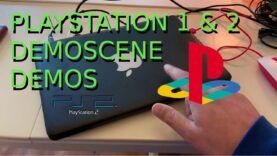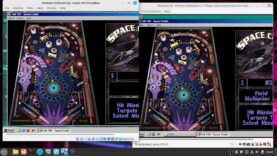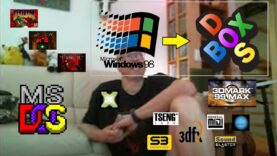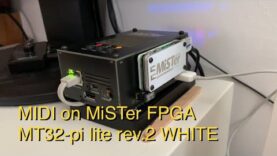 Checking Out Real MIDI Audio On My MiSTer FPGA with the MT32-Pi-Lite Rev 2
Checking Out Real MIDI Audio On My MiSTer FPGA with the MT32-Pi-Lite Rev 2 






Lactobacillus Prime
#misterfpga #midi #mt32pi
Ever since the Commodore 64 I was hooked to computer audio and music. My good friend Erwin had a Speccy and I loved that machine but the beeper audio contrasted sharply with the suave SID-Aurals my C64 could produce. Although I was very impressed by the polyphonic Manic Mine title screen music.
The MSX machines I had access to back in the day also came with all sorts of audio enhancers like the moon-sound and game-carts with additional audio chips.
When I got a PC it was a PC/XT NMS9100 Philips with EGA/VGA monochrome graphics and just the beeper. I did a lot of coding on the machine but compared to the MSX and C64 the gaming capabilities back then were quite limited. The PC beeper had a lot of Speccy Beeper nostaliga. I did experiment with PC speaker based Amiga MOD playback which sort of worked on the XT.
Then when I was graduating for my MD Master I got a 486 system to properly write my thesis on and do the statistics with SPSS/PC+ and that machine came with a Trident 9400xxx PCI VGA card, a SB16-SP soundcard and a dual speed CD-rom drive. I got my first experiences with FM-Synth and WAV / PCM playback on the PC and for a while that was amazing. Untill I got wind of the Gravis Ultrasound and the Gravis Ultrasound ACE.
Some people with deep pockets who were big into creating music actually had MT-32 and other Roland MIDI synths hooked up to their Atari-STs, PCs and Amigas but I could not afford those.
LGR demonstrated the MT-32 and other MIDI devices in one of his videos and my heart longed to be able to have similar audio for my retro-PCs
( 486SX33, AMD-K6-3, Pentium III and the MiSTer FPGA) and the MT-32 units look fantastic with their little displays. I was salivating and being appalled by the prices. So I was stuck with onboard audio, SB16 and/or combined with ISA Gravis Ultrasound ACE or the software implementation on the MiSTer itself that uses soundfonts but is glitchy for me. With the MT-32 high on the bucket list of holy grail devices just like the Commodore 1702 still is actually.
That is until now as I finally have a hardware MIDI solution (a bit of a hybrid hardware software solution really) for one of my retro PC experiences – the MiSTer FPGA – that gives me similar audio (sans the cool box with the fancy display but the MiSTer itself makes up for that). They come in various variants and revolve around a Raspberry Pi with a daughter board/extra hardware that gets hooked up to the MiSTer user port (the blue USB 3.0 looking port on the I/O board that is NOT a USB port but in fact rhe MiSTer user port). These Raspberry Pi-MT-32 solutions sound the part and are great but the MiSTer can be a bit of a cable disaster with cables coming off the device in just about all directions if you are using one of the stacked 3 board configs (USB hub – MiSTer – I/O board). I recently saw a solution with a Pi Zero that only requires to be plugged in to the USER port and used no other extra cables. Now that is something I can work with – plug in and play.
So I ordered the rev 2. MT32Pi-Lite from UltimateMister.com eith my own funds as. And I paid 73 euros incl taxes for it which to me is quite reasonable and worth the money. Today I received the package and took you guys along with most of the bits me unboxing it and trying it out.
Configuring it was quite easy.
– My MiSTer is very up to date and the MT32 already was enabled out of the Box so no need to run setup scripts or edit ini files. The only thing it needed doing was put the MT-32/CL Rom files in one directory and a bunch of .sf2 soundfiles in another on the Pi’s SD card which is easily accessible and files were transferred by sticking it in a cardreader and dragged the files over on my Linux box. It is possible to remotely configure it using scripts and shell commands as well as updating it. I figured the manual file copying worked best for my situation. And then it just worked.
The MiSTer does offer a built in soundfont enabled MIDI but that pales in comparison to the real hardware and the MT-32 Pi MIDI implementation hooked up to the MiSTer USER port. My MiSTer is a dual-ram digital I/O with optical audio out port. I hooked up my speakers over optical cable and a small DAC and the sound is AMAZING! It’s the clearest sound I’ve heard comping out of a MiSTer FPGA system to date.
Enjoy & thanks for watching
– LactobacillusPrime
My Facebook:
https://www.facebook.com/LactobacillusPrimeRetroGaming
My Instagram:
https://www.instagram.com/lactobacillus_prime
NOTICE:
“Copyright Disclaimer Under Section 107 of the Copyright Act 1976, allowance is made for “fair use” for purposes such as criticism, comment, news reporting, teaching, scholarship, and research. Fair use is a use permitted by copyright statute that might otherwise be infringing. Non-profit, educational or personal use tips the balance in favor of fair use.”










 Full Tilt! Pinball – Windows98 on VirtualBox & VMWare Side by Side (Next Level Multitasking)
Full Tilt! Pinball – Windows98 on VirtualBox & VMWare Side by Side (Next Level Multitasking) 






